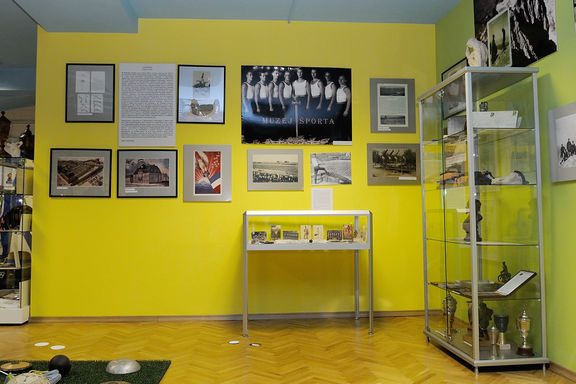Difference between revisions of "Slovene Sports Museum"
(update re management, links to Planica) |
|||
| Line 26: | Line 26: | ||
The [[Slovene Sports Museum]] was established in [[established::2000]] and houses a permanent exhibition of more than 8,000 artefacts, documents, and other records related to sports in Slovenia. The smallest and youngest national museum, it is still gathering artefacts. The permanent exhibition is under construction: documentation has been gathered; inventorying is in progress; a digital database is being updated; photos, audio and video files as well as documentary films are being collected and organised. | The [[Slovene Sports Museum]] was established in [[established::2000]] and houses a permanent exhibition of more than 8,000 artefacts, documents, and other records related to sports in Slovenia. The smallest and youngest national museum, it is still gathering artefacts. The permanent exhibition is under construction: documentation has been gathered; inventorying is in progress; a digital database is being updated; photos, audio and video files as well as documentary films are being collected and organised. | ||
| − | In 2016 the Slovene Sports Museum and its curator [[Iztok Durjava]] collaborated in setting up the collection of the [[Planica Museum]] dedicated to the history of ski jumping and flying, located in a newly constructed pavilion in the framework of the [[Nordic Centre Planica]]. | + | In 2016 the Slovene Sports Museum and its curator [[Iztok Durjava]] collaborated in setting up the collection of the [[Planica Museum]] dedicated to the history of ski jumping and flying, located in a newly constructed pavilion in the framework of the [[:Category:Nordic Centre Planica|Nordic Centre Planica]]. |
Today the [[Slovene Sports Museum]] as well as the [[Planica Museum]] are managed by the Institute of Sports of the Republic of Slovenia Planica. | Today the [[Slovene Sports Museum]] as well as the [[Planica Museum]] are managed by the Institute of Sports of the Republic of Slovenia Planica. | ||
| Line 44: | Line 44: | ||
==See also== | ==See also== | ||
| − | |||
* [[Planica Museum]] | * [[Planica Museum]] | ||
| − | * [[ | + | * [[:Category:Nordic Centre Planica|Nordic Centre Planica]] |
| − | + | ||
==External links== | ==External links== | ||
Revision as of 13:03, 9 March 2017
Collections
A few rooms of the museum are on view, but the permanent collection has not yet been organised, giving an impression of cabinets of curiosity. Donations and acquisitions of artefacts have been made by individuals, collectors, athletes, sport workers, experts and pioneers, mainly consisting of sport equipment, medals, cups, sport uniforms, etc. Slovenia is strong especially in winter sports (skiing, ski jumping), gymnastics, handball, basketball, shooting, swimming ... so the collection presents Slovene sport legends such as Mateja Svet, Mitja Petkovšek, Borut and Britta Bilač, Nataša Urbančič, Stanko Lorger, Cveto Pavčič, Bogdan Svet, Jure Zdovc, Mik Pavlovič, Marko Račič, Andrej Jelenc, and others. The collections comprise the Faculty of Sport Museum Collection with heritage of ski jump legend and construction engineer Stanko Bloudek, the Planica collection of Svetozar Guček, the Bikers Society of Slovenia Collection, etc. In 2004 the Slovene Sports Museum took over the Olympic Committee of Slovenia Archives.
Temporary exhibitions
The Slovene Sports Museum prepares temporary exhibitions that coincide with international sporting events such as the Soccer World Cup 2002, the Olympics and other world championships, as well as those taking place in Slovenia: the European Championship in Waterpolo 2003 in Kranj; the European Championship of Gymnastics for Men in Ljubljana (2004) with an exhibition on Miro Cerar, our most successful Olympic sportsman. In 2003 alongside the 140th anniversary of the founding of the South Sokol Society, an historical exhibition on this legendary group which marked the beginning of sport manifestations, sport clubs, and important political movements in Slovenia from the early 20th century, etc. took place and was visited by over 6,000 people.
Prospects
Research carried out in 1999 by Rajko Šugman and Marko Rožman (Sport Encyclopaedia of Slovenia) has shown that 21 % of Slovenes are active sportsmen. The Slovene Sports Museum definitely has its supporters and visitors, however, it needs better accommodation. One of solutions would be to place the museum in the Sports Park Stožice complex.
See also
External links
- Slovene Sports Museum website (in Slovenian)
- The first Slovene Sports Museum's web pages (in Slovenian)
- Slovene Sports Museum on Visit Ljubljana website



